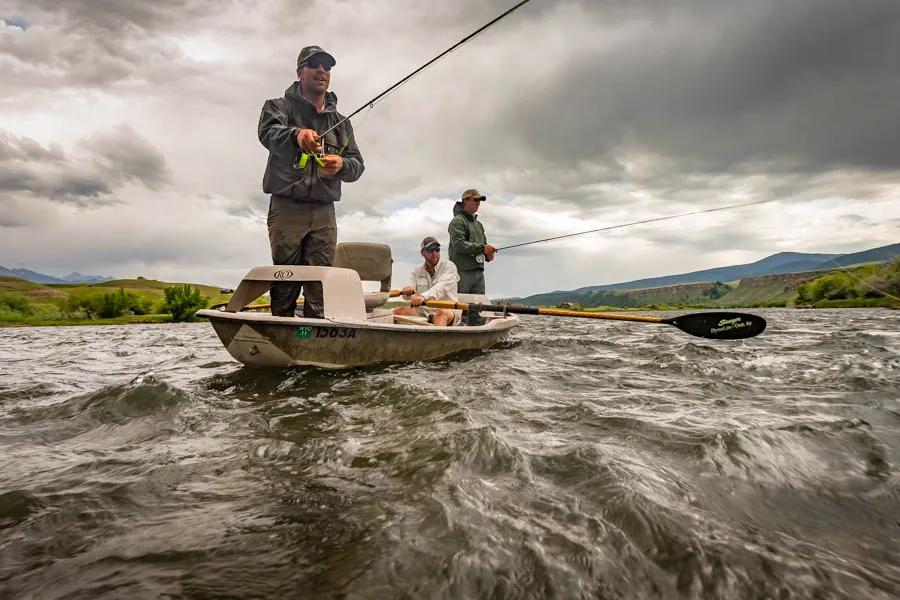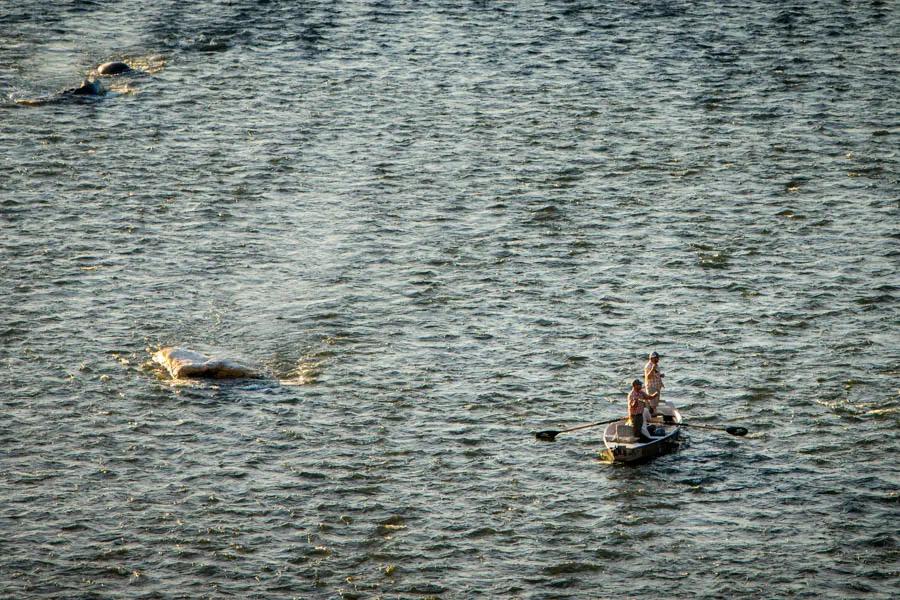
So, you’ve got a rod and reel, waders, and boots and fallen completely in love with fly fishing. You’ve spent late evenings on the Madison River casting caddis patterns to trout at last light. You’ve hiked long trails into the mountains in search of the elusive golden trout. And then one day your buddy gives you a call and wants to know if you’re up for a late-season float on the Yellowstone River. He’s got this idea that if float at twilight casting yellow streamers with a sink-tip line the two of you are bound to hook into something big. And then it happens.
You’ve thrown the perfect cast to a crook in the bank as the sun casts its orange glow on Emigrant Peak. Almost immediately your line goes tight and your reel rips as the fish tears out line. Your friend is cranking down on the oars to keep the fish in play. Sometime between that moment and lifting the net from the water with the biggest brown trout you’ve ever seen...it hits you:
You need a boat.
Whether you’ve fallen for the allure of a classic McKenzie River drift boat, or you’re intrigued by the potential of a packraft, there’s no shortage of quality fishing boats to choose from. Each design has its pros and cons. Here’s a few of our favorite types of fishing boats and some things to consider when you’re ready to buy a boat.

McKenzie River Drift Boat
The McKenzie River drift boat was developed in the mid-20th century to run rapids on the McKenzie River in western Oregon. Sometimes called a McKenzie River dory, the boat features a broad, flat bottom with flared sides, a flat bow and a pointed stern. The McKenzie features a continuous rocker from bow to stern that allows the vessel to pivot easily around its center point. It is an ideal boat for many of our Montana rivers.
McKenzie-style boats have become the iconic drift boat of Western fly-fishing rivers for good reason. Their ability to turn quickly, ample space for a cooler, extra rods, gear, and life jackets makes them excellent vessels for angling. Boat builders such as RO, Hyde, and ClackaCraft have modified the original McKenzie design to include built-in features like rod tubes, beverage holders, and swivel seats.
Because McKenzie’s have a rigid floor, anglers can stand in the bow and stern positions to cast. The ample space and rowing seat for an oarsman makes spending a day on the water with a fishing companion a practical consideration.
And there’s certainly no denying the romance of fishing from a McKenzie. If you’ve got the cash to spend, a spot to store it out of the elements, and the desire, a wooden McKenzie River drift boat is the height of fly-fishing luxury.

On the flipside, McKenzie River drift boats are heavy, expensive ($5,000-$20,000 for a new model), and require storage space or a sufficient weather proofing during the offseason. That means getting your drift boat in and out of some boat launches may be a challenge, and there are better options for low water conditions. You’ll want a garage, outbuilding, or a quality tarp to protect your boat. And you’ll need a trailer and a capable vehicle to tow your boat to the river.

Canoe
Canoes are lightweight boats that feature a narrow, elongated design. They have a pointed bow and stern and are propelled by one or more seated or kneeling paddlers using a single-blade paddle. Canoes were developed around the globe by a variety of cultures for myriad uses. Some canoes, typically the sea-faring variety, employ outriggers and sails, though the classic design germane to fly anglers features neither.
The hulls of early canoes were crafted of wood, which remains a popular and classic material widely used today. Other materials including aluminum, Royalex, fiberglass and Kevlar, provide canoes with differing properties that meet specific needs.
Canoes are great fly-fishing vessels for still and slow-moving waters and can be a great boat to access water on faster moving rivers. They allow anglers to approach fish with stealth and have plenty of space to pack gear. A canoe can be managed by a single angler from home to river and back, making them a great option for solo anglers. A decent boat can be had for under $1,000 and will last a lifetime with proper care.
While fly fishing from a canoe is a real joy when all goes well, it can be utterly frustrating when it doesn’t. The dividing line between success and failure often relies on the presence of a companion to navigate the boat from the stern as the angler fishes from the bow.
That’s not to say a canoe is an ineffectual fly-fishing vessel for the solo angler, quite the contrary. Trolling a fly behind a canoe on a lake or stream can be an effective means to catch trout. Just be aware that casting a rod and dealing with all the requirements of line management, netting of fish, etc., in addition to navigating a canoe with a paddle is a bit challenging on one’s own.

Raft
Rafts are boats characterized by the lack of a hull and date back to ancient times when logs were bound together to form early boats. Modern rafts used for fly fishing feature a metal frame and are made buoyant using inflated pontoons. As a result, rafts are lighter weight than drift boats which allows them to ride higher in the water column. Because they are not hard sided, they can glide more easily over rocks and shallow stretches of river.
Rafts are popular with fly anglers for their ability to navigate rivers with whitewater sections. Many rafts are now constructed with an inflatable bottom that is four- to five-inches thick. Drain holes on the top of the floor are located where the boat attaches to its perimeter pontoons. This design is known as a self-bailing raft and allows the boat to take on water without the need to bail.
Because of their durability, modular design, and ability to self-bail, rafts are perhaps the most useful all-around fly-fishing boat. They are equally adept at navigating whitewater, lakes, and slow-moving rivers. They have the ability to hold gear, though waterproof storage and tie-downs are essential.
The main drawbacks of fly fishing from a raft are often related to the practicalities of fly fishing itself. Rafts don’t fare as well as drift boats when it comes to line management and space is at a bit more of a premium. It’s not uncommon for your fly line to get caught up in the raft’s rigging, which can be frustrating.
A decent raft can be purchased new in the $3,000-$6,000 range. Rafts can be deflated and disassembled for storage. While they can be strapped to a truck frame or packed in the back of a vehicle, most anglers will want to tow their raft on a trailer.

Float Tube, Personal Pontoon, or Belly Boat
Float tubes, personal pontoons, and belly boats are small, lightweight inflatable vessels that resemble the inner tubes used to inflate truck tires. These boats used for fly fishing are typically V or U shaped and may include a back rest, mesh seat, rod and beverage holders, and a holster for a net.
Anglers fishing from these types of personal boats typically wear waders with scuba diving flippers to propel the vessel. While seated in the float tube the angler propels the boat with the flippers, which keeps the hands free for casting and landing fish.
These boats put anglers at waist level or very near the water--with some even their lower body literally submerged below the surface. This lower profile affords the fly angler a unique visual perspective not achievable in other vessels. Fishing from a float tube allows the angler to scan the water’s surface for aquatic insects and rising fish in a unique and enjoyable way. Personal pontoons have the angler sit higher than in a float tube or belly boat but still close enough for a unique perspective.
Float tubes, personal pontoons, and belly boats are the entry-level option in the world of fly-fishing watercraft, ranging from $100-$300 for most models. They can easily be stored in a garage and are wholly manageable for the solo angler prepared for a day on the water.
The biggest drawback to float tubes is they are not recommended for moving water.

Packraft
Packrafts represent the final frontier in the world of fly-fishing boats. These vessels are like a hybrid between a raft and a float tube with an emphasis on lightweight materials. They are generally designed for a solo angler, though tandem models are available. Packrafts are propelled by a double-blade paddle akin to that of a kayak. Packrafts were created with the idea that a solo boater could pack their watercraft in a backpack and hike into an area to boat. As such, packrafts are incredibly lightweight compared to other fly-fishing boats. Some packrafts, such as the Scout by Alpacka Raft, weigh in at less than four pounds.
The ability to pack a watercraft into a mountain lake and take the same vessel down a stretch of whitewater makes packrafts hyper-versatile fly-fishing watercraft, but they do come with a few caveats.
Packrafts need to be inflated before getting on the water and you’ll need to inflate them on site. Fortunately, most manufacturers offer a bellows or pump that makes inflation easier. Due to their lightweight construction, packrafts are not as durable as other fly fishing boats, so carrying a repair kit is a must. Finally, packrafts are small vessels and as such don’t provide room for coolers and other such luxuries.
An array of quality packrafts are now available from several manufacturers including Alpacka Raft and Kokopelli. Prices range from $500-$2,000.

Summary: What's the Best Fly Fishing Boat for You
There isn't a magic answer to this question. If that were the case there would be only one option for a fly fishing boat and our Montana fly fishing guides would all have the same style of boat. Fortunately, because there are lots of options of boats means there are lots of options of places to go fly fishing. Choosing the best boat really depends on the types of waters that you plan to fish. For larger and small rivers a drift boat or a raft make the most sense. If you plan to fish lakes and like to fish on your own, a personal pontoon or float tube might make the most sense. If you desire solitude and are willing to learn get out of the boat to fish and get back in the boat to cover distance, consider a canoe because a canoe can go places other boats cannot.
But if you are reading this article you are most likely already making the best choice of all...and that is to go fly fishing!
Montana Angler blog article by Ben Pierce.
